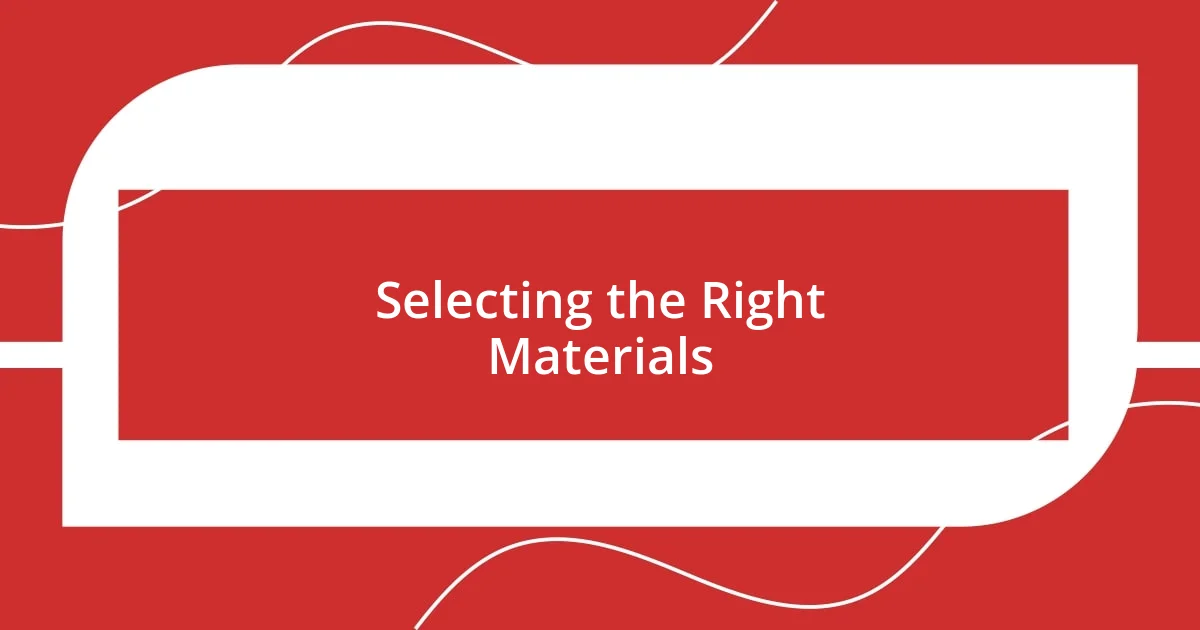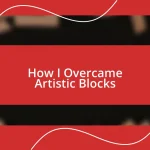Key takeaways:
- Choosing the right mural idea involves reflecting on the mural’s environment and integrating personal and communal stories.
- Careful planning, including sketching ideas, selecting harmonious colors, and creating mock-ups, is crucial for a successful mural design.
- Promoting the finished mural through social media, local events, and media outreach helps build a community and open up future opportunities for artists.

Choosing the Right Mural Idea
Choosing the right mural idea is a crucial first step that can define the entire project. I remember feeling overwhelmed by the possibilities when I planned my first mural. The vibrant colors and intricate designs danced in my mind, but I had to ask myself, “What message do I want to convey?”
It may help to start by reflecting on the space where the mural will reside. Is it a lively community center, a calming hospital corridor, or perhaps a children’s playground? The atmosphere greatly influences the mural’s theme. I once learned this the hard way; my whimsical design wasn’t quite the right fit for the more serious environment of a library.
Don’t hesitate to draw inspiration from your personal experiences or local culture. I took a stroll through my neighborhood and noticed the stories visible in every corner—each mural telling a tale. This taught me that merging personal and communal narratives creates a mural that truly resonates. What stories do you find compelling? That might just be the perfect starting point for your mural idea.

Planning Your Mural Design
To design a mural, careful planning is essential. I remember sketching my ideas on a notepad, allowing my thoughts to flow freely. Exploring different concepts through drawing helped me visualize what I wanted, and it made me realize how important the layout would be. Each stroke of my pencil represented a piece of the message I intended to communicate.
When I think about selecting colors, it’s not just about preferences; it’s about how they interact with each other. I’ve had moments where I chose a color palette that seemed perfect on paper but felt lacking in real life. For example, a dusty blue I loved in my sketches turned out too muted for the bright environment I was working with. Adjusting my colors while keeping the overall vibe in mind became a pivotal part of my planning process.
Before you dive into painting your mural, create a mock-up of your design. I often project my sketches onto the wall or use digital tools to give me a sense of scale and how it fits into the environment. This step brought me immense clarity and allowed me to refine my ideas based on the actual space I had to work with. It’s like trying on clothes before you buy them; it really helps ensure that everything feels just right.
| Planning Elements | Personal Experience |
|---|---|
| Sketching Ideas | Sketching helped me visualize my mural, defining my message early on. |
| Color Selection | I learned the hard way that my color choices must harmonize with their surroundings. |
| Mock-Ups | Creating mock-ups allowed me to test my design before committing to paint. |

Preparing the Wall Surface
To achieve the best results with your mural, preparing the wall surface is imperative. I recall the day before I started painting my first mural—it felt like getting ready for a big performance. The wall was rough and dirty, not at all the welcoming canvas I had imagined. I took my time to clean, inspect, and prime it to create a smooth foundation that made all the difference in my painting experience. It’s surprising how much a clean wall can enhance the vibrancy of the colors.
Here are some essential steps I followed for wall preparation:
- Clean the Surface: I scrubbed away any dirt, dust, or mildew. A clean surface helps the paint adhere better.
- Repair Imperfections: I filled in any cracks or holes with spackle, ensuring the surface was even and smooth.
- Sand the Wall: A light sanding created a surface that was primed and ready for paint, eliminating any bumps.
- Apply Primer: I painted a layer of primer to create a uniform base that helped my colors pop and last longer.
This preparation process not only set the stage for my mural but also put me in the right mindset to create something beautiful. It made me feel like I was truly investing in my art.

Selecting the Right Materials
Selecting the right materials is a critical step in creating a mural that truly stands out. When I embarked on my mural journey, I was surprised to learn how much of an impact choosing the correct paint can have. I opted for high-quality acrylic paint, which not only provided vibrant colors but also stood the test of time against outdoor elements. It’s essential to consider factors like durability and ease of application—trust me, this can save you from a lot of frustration down the line.
While gathering my materials, I discovered that the brushes I used made a world of difference. I initially thought any brush would suffice, but after experimenting with different types, I found that soft bristle brushes worked best for blending colors seamlessly. It’s fascinating how something as simple as a brush can affect the final outcome of your mural. So, take the time to test out a few options—it’s worth the investment.
Don’t forget about the importance of using proper sealing products, especially if your mural will be exposed to the elements. When I finished my mural, I felt an overwhelming sense of accomplishment, but that joy could have easily faded without a good sealer. I learned that applying a protective coat was crucial for maintaining my mural’s integrity and vibrancy over time. Wouldn’t you want all that hard work to shine for years to come?

Techniques for Painting a Mural
When painting a mural, techniques can make all the difference in the overall outcome. One technique I found invaluable was the use of a grid method for scaling up my design. As I meticulously measured out my sketch and transferred it onto the wall, I felt a mix of excitement and a slight tinge of anxiety. It was like mapping out a treasure hunt—each box leading me closer to completing my mural. I remember how incredibly satisfying it was to see my initial sketch come to life, even if some parts required a bit of tweaking along the way.
Layering is another essential technique I embraced wholeheartedly. In my experience, starting with a base layer of lighter colors and then gradually adding darker tones allowed for depth and dimension. The first time I blended colors in this way, it felt magical; the mural almost seemed to breathe with life. Have you ever seen how shadows can create an illusion of movement? That’s exactly what I aimed for, and the results were stunning. Experimenting with layering taught me that patience is key; I often found myself stepping back, assessing the work, and then diving back in without losing my original vision.
Lastly, I can’t stress enough the importance of brush techniques. Using different brush strokes can express so much emotion and energy in your mural. I remember playing around with stippling during the making of my mural—it was like adding a sprinkle of magic. This technique not only added texture but also gave my work a playful quality. It’s amazing how the way we apply paint can dramatically change the feel of a piece. Have you ever tried a different brush stroke and noticed a shift in your artwork? It’s those little discoveries that make the painting process so fulfilling and enjoyable.

Adding Finishing Touches
Adding those final touches to my mural was a moment filled with excitement and anticipation. As I stood back to assess my work, I realized the importance of details; simple elements like highlights and shadows can either make or break the overall impact. I vividly remember adding the last stroke of white paint to a tree in my mural, and it felt like injecting life into it—not just paint, but a delicate touch of magic. Have you ever watched a painting shift when the light catches it just right? It’s transformative.
I also found that signature details could personalize my artwork even further. For my mural, I decided to incorporate small, whimsical patterns that reflected my personality—little shapes and symbols that spoke to my journey and experiences. One night, under the soft glow of a streetlamp, I couldn’t help but smile as I painted a tiny heart hidden among the leaves. It was like a secret just for myself and anyone who took the time to notice. Those small touches not only tied the piece together but also infused it with my spirit, creating a sense of connection with anyone who would eventually view it.
Lastly, I learned the emotional weight of stepping away and really looking at your mural from a distance. Sometimes, I’d be so engrossed in the individual details that I lost sight of the overall composition. After taking a break and coming back with fresh eyes, I could identify areas that needed a bit more love or even some adjustments. I remember stepping back and realizing the colors needed one more layer to really pop; that moment of clarity made all the difference. Doesn’t that feeling of really seeing your work for what it is just thrill you? Closing that chapter of creation with a sense of fulfillment is what this journey is all about.

Promoting Your Finished Mural
Promoting your finished mural goes beyond just showcasing your work; it’s about telling a story. I decided to document my mural journey on social media, sharing progress photos and my creative process. The response was invigorating! Friends and followers engaged with every update. Have you ever shared a project and felt that rush of excitement when others express genuine interest? It’s not just gratifying; it builds a community around your art.
I also organized a small unveiling event where I invited local artists and friends. It was thrilling to showcase the mural in person and hear their feedback. I remember feeling a wave of emotion as people admired the colors and patterns I poured my heart into. Their reactions reminded me why I started this mural in the first place. What’s better than seeing your work elicit smiles and conversations? That night, I realized that art isn’t just meant to be observed; it’s meant to connect and spark dialogue.
Another effective strategy I employed was reaching out to local media. I wrote a brief article about my mural’s inspiration and my creative process, then sent it to community newsletters and blogs. I was surprised to see it published, gaining attention from people outside my immediate circle. This outreach not only expanded my audience but also opened up opportunities for future projects. Have you ever thought about how sharing your art can lead to unexpected doors? It’s an essential step that I encourage every muralist to consider.















